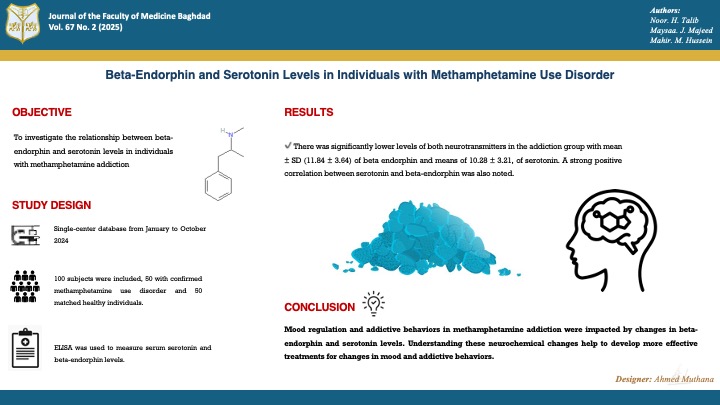Beta-Endorphin and Serotonin Levels in Individuals with Methamphetamine use Disorder
DOI:
https://doi.org/10.32007/jfacmedbaghdad3121Keywords:
Beta-endorphin, ELISA, Methamphetamine addiction, Mood regulation, Neurotransmitters, SerotoninAbstract
Background: Alterations in the levels of beta-endorphins and serotonin are heavily involved in the mood dysregulation regularly observed in individuals with methamphetamine use disorder, with lower levels of these neurotransmitters contributing to mood disturbances commonly seen in addiction. Such neurochemical imbalances may also disrupt normal mood regulation pathways, leading to the emotional and psychological challenges often experienced by individuals struggling with addiction.
Objective: To investigate the relationship between beta-endorphin and serotonin levels in individuals with methamphetamine addiction, and to evaluate their potential roles in mood regulation and addiction-related behaviors.
Methods: This observational study assessed the serum levels of beta-endorphin and serotonin in individuals with methamphetamine use disorder compared to healthy controls. Fifty patients with confirmed methamphetamine use disorder and fifty matched healthy individuals were recruited. ELISA (Enzyme-linked immunosorbent assay) was used to measure serum serotonin and beta-endorphin levels. Research permission was obtained with ethical approval from the Health Research Ethics Committee.
Results: The results showed significantly lower levels of both neurotransmitters in the addiction group with mean ± SD (11.84 ± 3.64) of beta endorphin and means of 10.28 ± 3.21, of serotonin. A strong positive correlation between serotonin and beta-endorphin was also noted. These findings suggest a critical role of these neurochemicals in the mood disturbances associated with methamphetamine addiction.
Conclusion: Mood regulation and addictive behaviors in methamphetamine addiction were impacted by changes in beta-endorphin and serotonin levels. Understanding these neurochemical changes help to develop more effective treatments for changes in mood and addictive behaviors.
Received: Jan. 2025
Revised: April 2025
Accepted: June 2025
Published Online: June 2025
Published: July 2025
References
1. Shahbaa Waheed Sami, Basil O. Saleh, Muataz A AL-Qazzaz. The Use of Serum Endothelin1and Myoglobin in the Evaluation of Renal Injury in Methamphetamine Abusers. Indian J Forensic Med Toxicol. 2021;15(4):3487–92. https://doi.org/10.37506/ijfmt.v15i4.17812.
2. Kristi L. Stringer, Bulent Turan, Lisa McCormick, Modupeoluwa Durojaiye, Laura Nyblade, Mirjam-Colette Kempf, Bronwen Lichtenstein and JMT. Neurotoxicity of methamphetamine. Physiol Behav. 2022;176(3):139–48. https://doi.org/10.1016/j.expneurol.2021.113795.
3. Arazi H, Dadvand SS, Suzuki K. Effects of exercise training on depression and anxiety with changing neurotransmitters in methamphetamine long term abusers: A narrative review. Biomed Hum Kinet. 2022;14(1):117–26. https://doi.org/10.2478/bhk-2022-0015.
4. Yu S, Zhu L, Shen Q, Bai X, Di X. Recent advances in methamphetamine neurotoxicity mechanisms and its molecular pathophysiology. Behav Neurol. 2015;2015. https://doi.org/10.1155/2015/103969.
5. Yaseen A, Talib M. Prevalence and Clinical Characteristics of Depression among Elderly Patients Attending Primary Health Care Centers in Diyala Governorate. J Fac Med Baghdad. 2023;65(2). https://doi.org/10.32007/jfacmedbagdad.2034.
6. Michely J, Eldar E, Martin IM, Dolan RJ. A mechanistic account of serotonin’s impact on mood. Nat Commun. 2020;11(1). https://doi.org/10.1038/s41467-020-16090-2.
7. Schoenfeld TJ, Swanson C. A runner’s high for new neurons? Potential role for endorphins in exercise effects on adult neurogenesis. Biomolecules. 2021;11(8). https://doi.org/10.3390/biom11081077.
8. Jasim EM. Use of dietary supplements in a sample of Iraqis. J Fac Med Baghdad. 2022;64(1):37–41.
https://doi.org/10.32007/jfacmedbagdad.6411871.
9. Si Z, Yang GJ, Wang X, Yu Z, Pang Q, Zhang S, et al. An unconventional cancer-promoting function of methamphetamine in hepatocellular carcinoma. Life Sci Alliance. 2023;6(3). https://doi.org/10.26508/lsa.202201660.
10. Boileau I, McCluskey T, Tong J, Furukawa Y, Houle S, Kish SJ. Rapid Recovery of Vesicular Dopamine Levels in Methamphetamine Users in Early Abstinence. Neuropsychopharmacology. 2016;41(4):1179–87. https://doi.org/10.1038/npp.2015.267.
11. Čechová B, Šlamberová R. Methamphetamine, Neurotransmitters and Neurodevelopment. Physiol Res. 2021 Dec 1;70:301–15. https://doi.org/10.33549/physiolres.934821.
12. Shrestha P, Katila N, Lee S, Seo JH, Jeong JH, Yook S. Methamphetamine induced neurotoxic diseases, molecular mechanism, and current treatment strategies. Biomed Pharmacother. 2022;154. https://doi.org/10.1016/j.biopha.2022.113591.
13. Singh PK, Lutfy K. The Role of Beta-Endorphin in Cocaine-Induced Conditioned Place Preference, Its Extinction, and Reinstatement in Male and Female Mice. Front Behav Neurosci. 2021;15(December):1–8. https://doi.org/10.3389/fnbeh.2021.763336.
14. Pilozzi A, Carro C, Huang X. Roles of β-endorphin in stress, behavior, neuroinflammation, and brain energy metabolism. Int J Mol Sci. 2021;22(1):1–25. https://doi.org/10.3390/ijms22010338.
15. May AC, Aupperle RL, Stewart JL. Dark Times: The Role of Negative Reinforcement in Methamphetamine Addiction. Front Psychiatry. 2020;11(March). https://doi.org/10.3389/fpsyt.2020.00114.

Downloads
Published
Issue
Section
Categories
License
Copyright (c) 2025 Noor H. Talib, Maysaa J. Majeed , Maher M. Hussein

This work is licensed under a Creative Commons Attribution 4.0 International License.










 Creative Commons Attribution 4.0 International license..
Creative Commons Attribution 4.0 International license..


